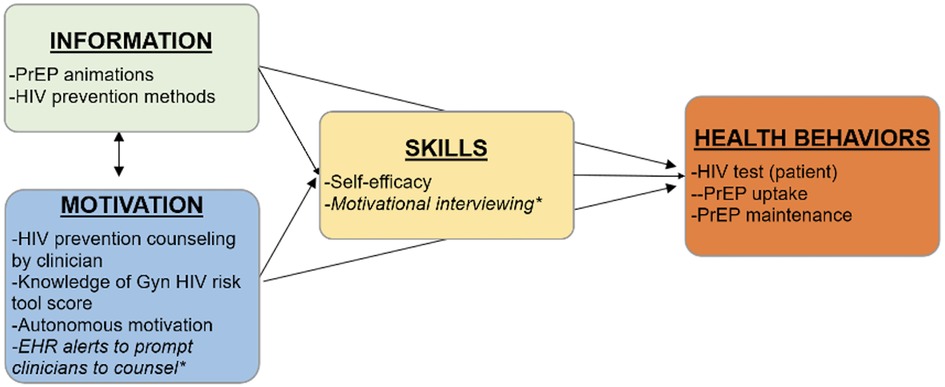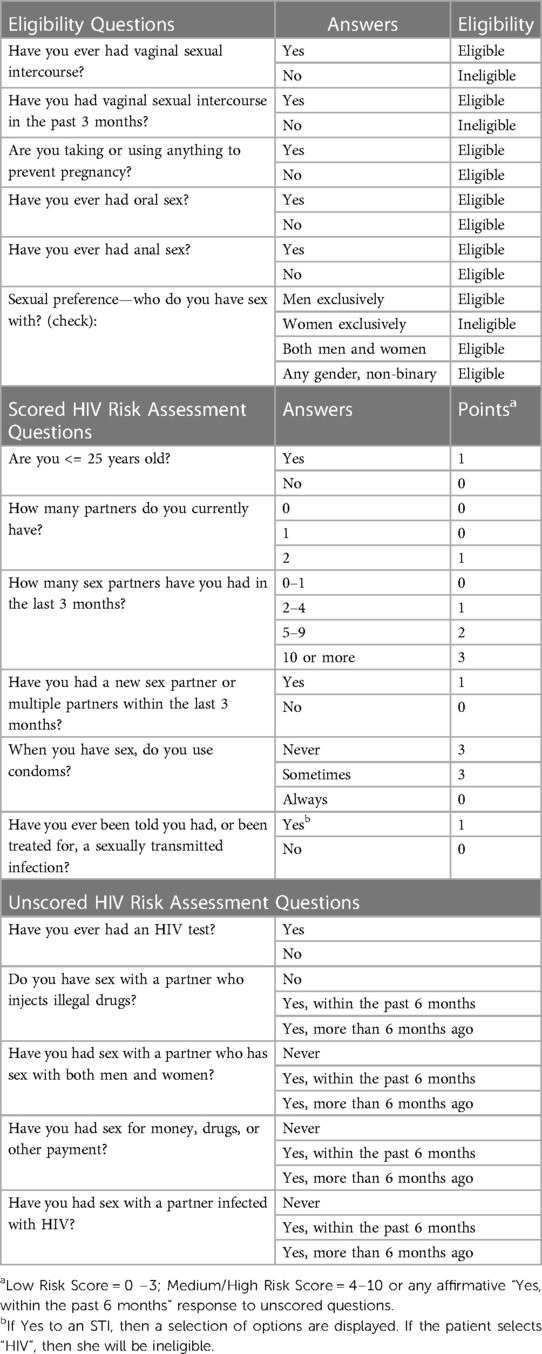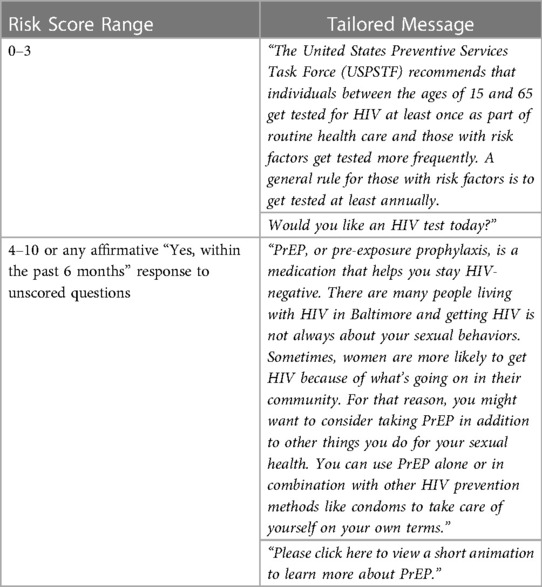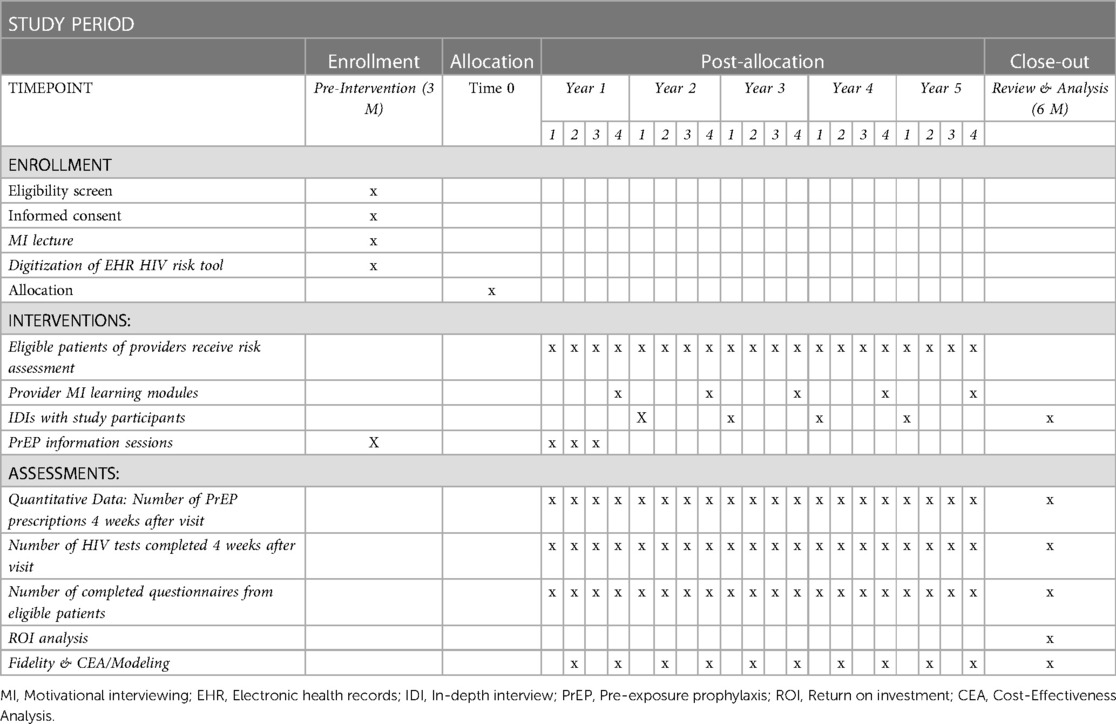- 1Department of Gynecology and Obstetrics, Johns Hopkins School of Medicine, Baltimore, MD, United States
- 2Department of Obstetrics and Gynecology, University of Michigan Medical School, Ann Harbor, MI, United States
- 3Department of Health Policy and Management, Johns Hopkins Bloomberg School of Public Health, Baltimore, MD, United States
- 4Department of International Health, Johns Hopkins Bloomberg School of Public Health, Baltimore, MD, United States
- 5Department of Obstetrics and Genecology, Johns Hopkins Community Physicians, Baltimore, MD, United States.
Background: The United States' (U.S.) initiative to End the HIV Epidemic aims to reduce new HIV infections in areas of high HIV prevalence. Despite national efforts to reduce HIV incidence, cisgender women continue to represent approximately one out of every five new HIV diagnoses in the U.S. Taking pre-exposure prophylaxis (PrEP) is an effective HIV prevention strategy; however, PrEP initiation among cisgender women is suboptimal, with only 10% of eligible women receiving PrEP prescriptions in 2019.
Methods: We designed a trial to test the effectiveness of interventions to increase PrEP initiation, while evaluating the implementation strategy (hybrid type II trial) in seven obstetrics and gynecology (OB/GYN) clinics (two federally qualified health centers, three community-based, and two academic) in Baltimore, Maryland. A total of 42 OB/GYN providers will be enrolled and randomized (1:1:1) into one of three clinical trial arms (standard of care, patient-level intervention, or multi-level intervention). Eligible patients of enrolled providers will receive a sexual health questionnaire before their appointment through the electronic health record’s (EHR) patient portal. The questionnaire will be scored in three tiers (low, moderate, and high) to assess HIV risk. Patients at low risk will be offered an HIV test only, while those who score medium or high risk will be included in the clinical trial and assigned to the clinical trial arm associated with their provider. Differences in PrEP initiation, our primary outcome, across the three arms will be analyzed using generalized linear mixed-effect models with logistic regression. We will adjust results for demographic differences observed between arms and examine PrEP initiation stratified by patient’s and provider’s race and ethnicity.Additionally, a comprehensive economic analysis for each intervention will be conducted.
Discussion: We hypothesize that gathering information on sensitive sexual behaviors electronically, communicating HIV risk in an understandable and relatable format to patients and OB/GYN providers, and deploying EHR alerts will increase PrEP initiation and HIV testing.
Trial Registration: The trial is registered with ClinicalTrials.gov (NCT05412433) on 09 June 2022. https://clinicaltrials.gov/ct2/show/NCT05412433?term=NCT05412433&draw=2&rank=1.
Introduction
Cisgender women comprise approximately one out of every five new HIV diagnoses in the United States in 2019, and eighty-five percent of cisgender women diagnosed with HIV attribute it to heterosexual contact (1). Consistent condom use and daily oral tenofovir disoproxil fumarate 300mg-emtricitabine 200 mg (TDF-FTC) as HIV pre-exposure prophylaxis (PrEP) are evidence-based behavioral and biomedical interventions for women to reduce their risk of HIV acquisition. Yet, cisgender women experience many barriers to accessing PrEP (2).
TDF-FTC, the only oral Food and Drug Administration (FDA)-approved PrEP medication for women, has been authorized for use since 2012 (3). However, recent data show that only up to 44% of women have heard of PrEP (2), and 1%–6% of PrEP users are women (4, 5). Underestimation of HIV risk is a leading cause of poor PrEP initiation (2). In one study, 85% of obstetrics and gynecology (OB/GYN) clinic patients in a high HIV prevalence city considered themselves low risk for HIV acquisition (2). Thus, only 41% reported using condoms when having sex with one or multiple partners in the preceding three months (2). The discordance between HIV risk perception and actual HIV risk is exacerbated when women are unaware of their male partners' HIV serostatus and HIV risk factors (2, 6). Twice as many Black men living with HIV reported having sex with both men and women compared to White men living with HIV (34% vs. 13%) (1). Provider-level reasons contributing to poor PrEP initiation among cisgender women include clinical time constraints, the inability to assess or discomfort with assessing their patients' risk for HIV acquisition, and lack of knowledge (7–9). The inability to assess HIV risk was evident in our prior data from a pregnant population in a city with high HIV prevalence. We showed that repeat HIV testing was rarely ordered (<30%) at three months, despite a state mandate (10), patients diagnosed with recurrent sexually transmitted infections (STIs), or patient report of new sexual partners and inconsistent condom use (11).
The Centers for Disease Control and Prevention's (CDC) recommendation to inform all sexually active adults and adolescents about PrEP may help to increase PrEP discussions (12), However, strategies are needed to prompt these discussions. Therefore, we designed a trial to address known patient- and provider-level barriers to PrEP, including short PrEP educational animations, electronic health record (EHR) decision support tools, and an HIV risk assessment. To ensure the interventions' effectiveness and feasibility, it is crucial to conduct a comprehensive cost analysis. This analysis will allow researchers and policymakers to evaluate an economic evaluation of the interventions compared to standard care, providing valuable insight into the allocation of limited resources in healthcare systems. By quantifying the costs associated with the intervention, including implementation, maintenance, and training expenses, stakeholders can make informed decisions about the scalability and sustainability of the proposed approach. Furthermore, a detailed cost analysis will facilitate the identification of potential barriers to adoption and inform the development of strategies to overcome these obstacles, ensuring that the intervention is both financially viable and accessible to the target population.
We hypothesize that by gathering information on sensitive sexual behaviors electronically, communicating HIV risk in an understandable and relatable format to patients and OB/GYN providers, and automating parts of clinical care (e.g., EHR alerts, facilitating HIV test ordering), PrEP initiation and HIV testing will increase.
Methods
Study design & setting
We designed a trial to test the effectiveness of the intervention, while evaluating the implementation strategy (hybrid type II effectiveness-implementation trial) that will be launched in seven OB/GYN clinics (three community-based, two academic, and two federally qualified health centers) affiliated with a large health system in Baltimore, Maryland. Baltimore Metropolitan Statistical Area is one of the 57 jurisdictions targeted in the Ending the HIV Epidemic (EHE) in the U.S (5). and in 2019 had an HIV incidence of 17 per 100,000 and a prevalence of 788 per 100,000 (13). Women made up 28% of new HIV diagnoses with 70% of cases transmitted via heterosexual contact and 15% via injection drug use (13).
Study population
Inclusion criteria for patients of enrolled OB/GYN providers include age 15–65 years, scheduled for an annual gynecology exam (i.e., routine checkup), STI testing, or contraceptive counseling, and does not have an HIV diagnosis in the medical record. The age range was selected based on the U.S. Preventive Services Task Force (USPSTF) HIV Testing Recommendations and the PrEP FDA-approved age of 15 years (3, 12, 14). Women who have initiated prenatal care or are taking PrEP will be excluded.
Study intervention
Our intervention and implementation strategies are based on the Information, Motivation, and Behavior Model (IMB) of behavior change (Figure 1). Enrolled OB/GYN providers (e.g., physicians, nurse practitioners, nurse midwives, and physician assistants) from the preselected clinics will undergo brief, 30–60-minute motivational interviewing training sessions quarterly throughout the trial. Additionally, microlearning PrEP sessions will be held to aid providers in assessing PrEP eligibility and PrEP medication management. Then, providers will be randomized to one of three arms: (1) standard-of-care arm, (2) a patient-level intervention arm, or (3) a patient-and-provider level intervention arm.
All eligible patients scheduled to receive care from an enrolled provider will be sent a link to complete an electronic sexual history questionnaire to fill out prior to their appointment. This questionnaire has 17 detailed sexual history questions [e.g., type of sex (anal, vaginal, oral), sexual orientation, number of partners, number of new partners, prior STIs], which were adapted from other HIV/STI risk assessment tools (11, 14, 15). Table 1 displays the assigned value to each question with final scores ranging from 0 to 10 (0–3 we defined as a patient at low-risk of acquiring an HIV infection, whereas 4–10 we defined as a patient at medium-to-high risk of acquiring HIV infection).
Patients who score 0–3 in any arm will only be offered an HIV test per USPSTF guidelines (14, 16), whereas those who score 4–10 will be considered PrEP-eligible and entered into the trial. These PrEP-eligible patients will then undergo intervention based on their provider's randomization. If their provider was randomized to arm 2, then the patient will be given a personalized message based on their sexual history questionnaire responses (Table 2) and view a 2.5-minute PrEP animation. Conversely, if their provider was randomized to arm 3, then patients will receive similar interventions to those in arm 2, but with the addition of the providers being sent a best practice alert (BPA) via the EHR advising them to offer PrEP (Figure 2).
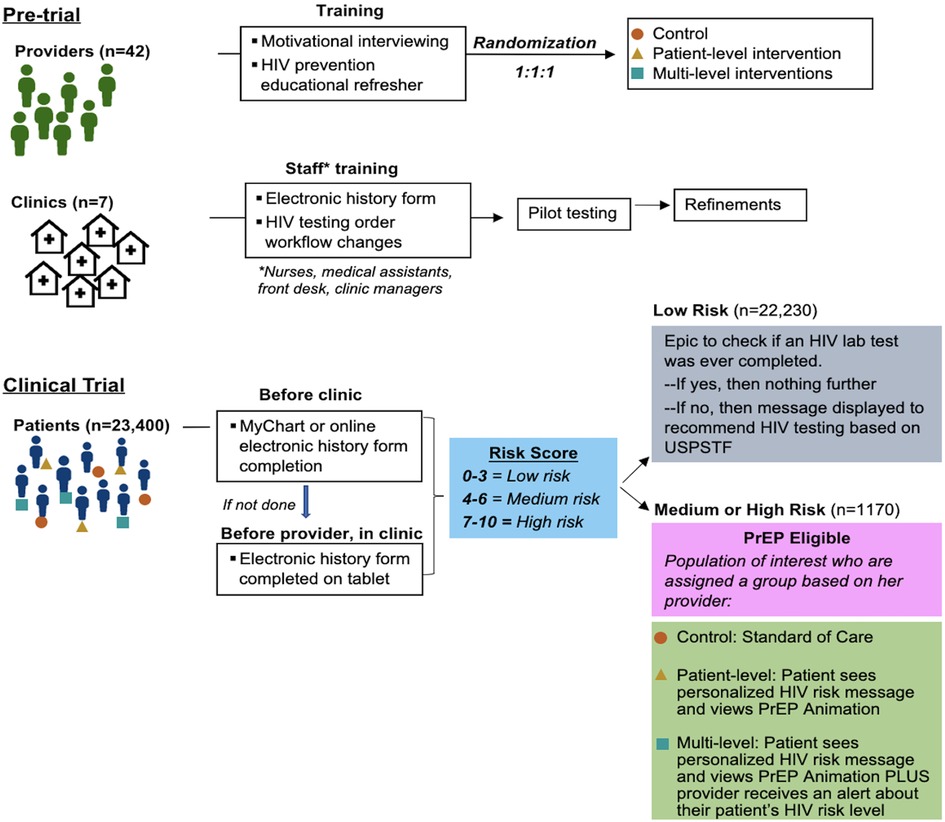
Figure 2. Study schema. There are two phases in the project. The first is to prepare documents, train staff, enroll providers and clinics. The second includes the clinical trial.
Data collection
Patient-level data and risk scores will be extracted by study staff and stored on a secured analytic framework environment, with access granted to designated study staff. To better identify barriers and facilitators to the intervention or implementation strategy, we will also conduct focus group discussions during clinic staff meetings and semi-structured, 45-minute in-depth interviews (IDIs) among interested clinic staff, providers, and patients. The interviews will include approximately 10 patients from each sexual history questionnaire score category (n = 30, low, medium, and high), 10 providers, and 10 members of the clinic staff. Participants will be compensated for their time and participation.
An outlined timeline for execution of provider recruitment, pre-trial training, pilot testing, data collection, and results analysis is detailed in the SPIRIT table (Table 3) below. As this study is a cluster-randomized trial, a proposed CONSORT flow diagram is included which will depict the status of provider enrollment and their exposure to allotted interventions (Figure 3). SPIRIT, CONSORT, and TIDIeR compliant checklists are provided in Supplementary Additional Files S1–S3, respectively.
Randomization
All eligible and consenting providers will be randomized to one of the three research arms based on restricted randomization using methods developed by Sismanidis and Moulton, et al. (17), such that clinic site, patient volume, and the prevalence of bacterial STIs (i.e., syphilis, gonorrhea, and chlamydia) in the patient population for each arm will be similar. This restricted randomization approach reduces covariate imbalances by enumerating a large set of possible allocations where balance among the above factors will be within acceptable limits, and then selecting one allocation at random using a random number generator. These limits will be specified for clinic sites such that the difference between the number of providers in any site will be no more than two, and for patient volume and prevalence of bacterial STIs such that the variability among arms will be within 10%. We will examine at least 1 × 10E19 possible allocations to determine which will meet our balance criteria. We will examine the validity matrix (the probability of being in the same arm for all provider pairs) for the balanced replications to determine if they are acceptable (18). Should some recruited providers withdraw from the study during its duration, they will be replaced with new providers. New providers who agree to participate in the study will be recruited and allocated to the intervention arms based on a block-randomized schedule with a block size of three, stratified by site. IRB-approved research coordinators and assistants blinded to the study will enroll and consent the providers and a co-investigator who is blinded to provider identification will generate the allocation sequence using R version 4.2.2 or other equivalent statistical software. Allocation concealment will be ensured as the person in charge of randomization will not be involved in the recruitment of providers, nor release the randomization sequence to any participants or research team members.
Ethical & regulatory considerations
The Johns Hopkins Medicine Institutional Review Board (IRB) approved the study. The approval letter, and a copy of the approved study protocol, can be found in Supplementary Additional Files 4 & 5, respectively. Informed consent will be obtained from all providers and participants for all components of the study. A waiver of written informed consent was granted for the patients of the enrolled providers as the study was deemed minimal risk for three main reasons. First, the probability and magnitude of harm or discomfort anticipated in the research were not deemed greater than those ordinarily encountered in a routine clinical evaluation. The main risks to patients include breach of confidentiality and the possible risk of change from the standard of care (e.g., possible display of a personalized HIV risk message). Second, many of the HIV risk assessment questions are routine components of a comprehensive sexual history that national organizations [i.e., CDC and American College of Obstetricians and Gynecologists (ACOG)] recommend (19, 20). Third, all the methods planned for use in this study are currently accepted, recommended, and utilized in clinical visits within our health system.
Sample size estimate
A priori sample size calculation for the three-arm randomized control trial (RCT) was based on the expected annual patient volume across seven clinics of approximately 9,100. We made the conservative assumption that 5%–10% of these will score medium or high-risk on the sexual history questionnaire based on our preliminary studies (21), yielding at least 390 patients annually, with a total of 1,170 over the three-year enrollment period. Our estimate is conservative as we found that close to 70% of adolescent and young adult women in one of our clinics scored medium or high, but these were adolescents and young adult women with the highest prevalence of STIs and risk behaviors (14). Given that patients using the same provider are not likely to be strongly related to each other in their choices for PrEP initiation (our primary outcome), we assumed a low intra-provider correlation (IPC) of 0.01, with on average 28 patients per provider per year, yielding a design effect of 1 + (28–1) * IPC = 1.27. Given these assumptions, if we estimate PrEP initiation at 6% (preliminary data) (15), we can detect a difference of 9% (from 6 to 15%) between arms with 80% power. We will examine the intervention effect within specific race/ethnicity groups. Assuming we have approximately 50% non-Latinx Black patient participants (as we do for the general patient population), we expect to enroll 585 non-Latinx Black patients, allowing for 80% power to detect a difference of 6% in PrEP initiation in the standard of care arm to 15% in the intervention arms, assuming the same design effect of 1.27.
Outcomes & measures
We will use the Reach-Effectiveness-Adoption-Implementation-Maintenance (RE-AIM) framework to guide our analysis plan (Table 4). The primary effectiveness outcome is PrEP initiation, measured by the proportion of PrEP prescriptions written within 4 weeks of the patient's clinic visit. The primary implementation strategy outcome is sexual history questionnaire completion, measured by the proportion of patients who have a completed questionnaire in the EHR. Secondary outcomes for this study are HIV testing, comprehensive economic analyses, and fidelity measurements to determine implementation feasibility.
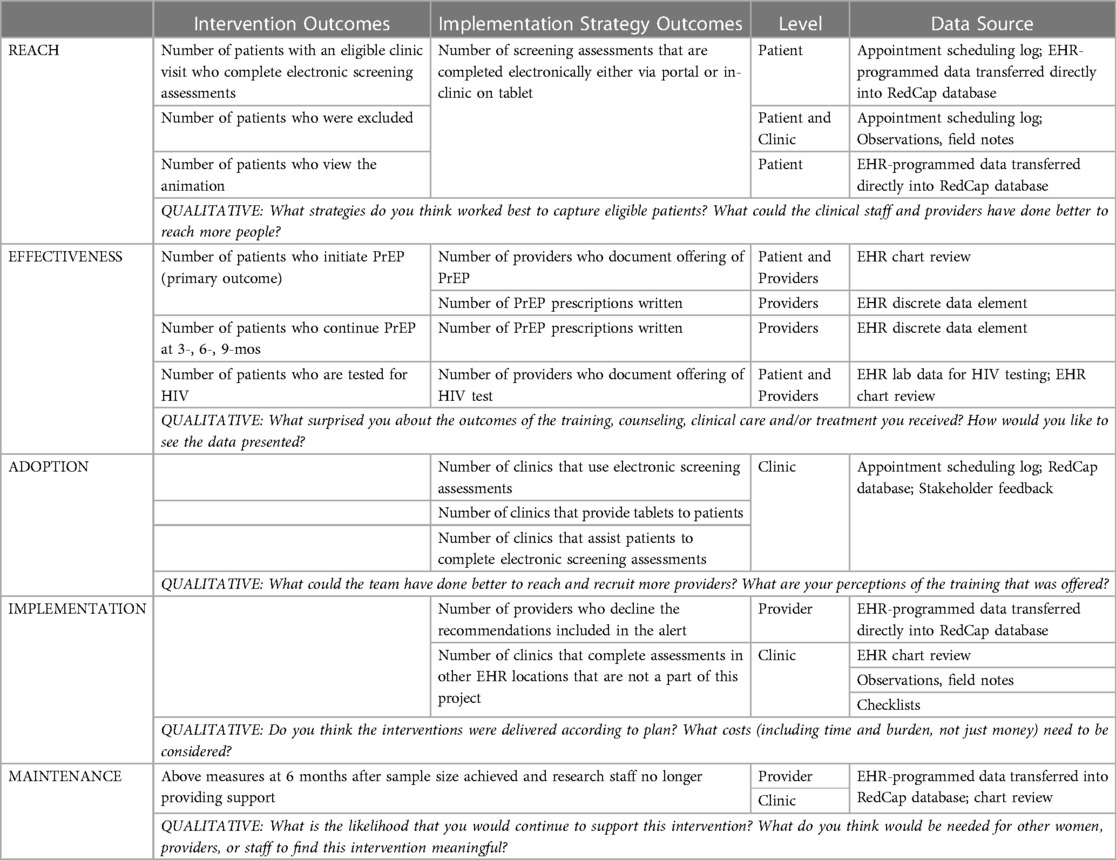
Table 4. Intervention and Implementation quantitative and qualitative outcomes using the RE-AIM framework.
Quantitative data analysis
We will examine whether randomization to the three intervention arms resulted in similar provider and patient groups by comparing patient and provider-level demographics with descriptive statistics. Comparison of PrEP initiation (primary outcome) between arms will be conducted based on provider arm assignment, in accordance with the intention to treat. We will use generalized linear mixed-effect models (GLMM) with logistic regression to examine the difference in PrEP initiation across arms (15). This model will allow us to consider within-and across-participant variability, while also controlling for random variables to form a multivariate normal distribution (15, 22). More specifically, we will use this model to adjust PrEP initiation comparisons for any demographic differences between arms and examine the primary outcome stratified by race/ethnicity. In exploratory analyses, we will determine whether intervention effects attenuate over time, as providers and patients may become accustomed to the intervention.
Similar to our methods for comparing the primary outcome between providers, we will also compare the rate of HIV test completion with generalized linear mixed-effect models with provider and patient-level random effects. We will consider adjusting for imbalanced factors between arms in these analyses. In addition, we will also examine PrEP initiation among low risk scoring patients to determine whether providers receiving the intervention are more generally influenced in their behavior or if the intervention effect is specific only to intervention patients. All questionnaire data will be collected via the EHR, and the R programing language (version 4.1) will be used for analyses. Datasets generated and analyzed during this study will be made publicly available upon publication of results in an institutional repository.
Qualitative data analysis
We will conduct an explanatory sequential design because the quantitative study is conducted first, followed by a qualitative evaluation to explain or expound on the quantitative findings (23). Certain quantitative measures (e.g., demographics, satisfaction rates) will be imported into the Dedoose® database. Simple inferential statistics for two-way tables (e.g., Chi-square) will be used to evaluate thematic differences between groups by site, demographics, and other critical predictors identified in the quantitative analyses. Demographic and clinical data will be used to determine associations between survey responses and demographic variables.
Economic evaluation
We will first conduct a cost-effectiveness analysis (CEA) from the perspectives of a payer or an adopting organization (e.g., Medicaid), to evaluate the cost and benefit tradeoffs of adopting alternative intervention strategies. We will use standard analytical methods recommended by the Second Panel on Cost-Effectiveness Analysis (Table 5) to estimate the effectiveness and economic costs of each active intervention (i.e., patient-focused intervention and patient-focused intervention plus EHR alerts) and standard of care (24–27). Costs will be estimated from the perspective of an adopting organization or payer (e.g., Medicaid), and will include both program implementation costs, the direct medical costs related to STI testing, treatment and counseling, and costs associated with other medical care resource use, over the observation period (1 year). We will exclude all research-related costs, such as those related to the implementation of the trial itself (e.g., research staff time). A micro-costing approach will be used to track all major and relevant resource items used to implement the intervention and their associated unit costs over a one-year period (28, 29). Individual resource item costs will be calculated by multiplying the units of resource use with the unit costs of each resource item. We will combine these costs to calculate the total cost of implementing each intervention. The implementation costs of home-based STI testing will be defined to include those associated with resources used for specimen collection for STI testing and retesting, STI counseling and treatment and partner therapy, as well as for the monetary and non-monetary (i.e., electronic vouchers) incentives, logistics (e.g., transportation), and the administration and delivery of each intervention. We will track the units of STI tests and STI counseling sessions, medication prescriptions, clinical and non-clinical staff time, and medical care visits. The unit costs of STI tests and counseling sessions will be derived from the existing literature, cost charts, and fee schedules. Clinical staff time will be defined to include doctor, nurse, and STI counselor time spent with the patient; non-clinical staff time will be defined as any other staff time spent on the patient. We will record staff time in minutes used by the study's staff (both clinical and non-clinical) to conduct the program's activity. We will use the average salaries for staff to estimate an average unit cost per encounter. Staff salaries will be obtained from the published list of public sector salaries for specific occupations. We will combine these costs to calculate the total cost of implementing each intervention.
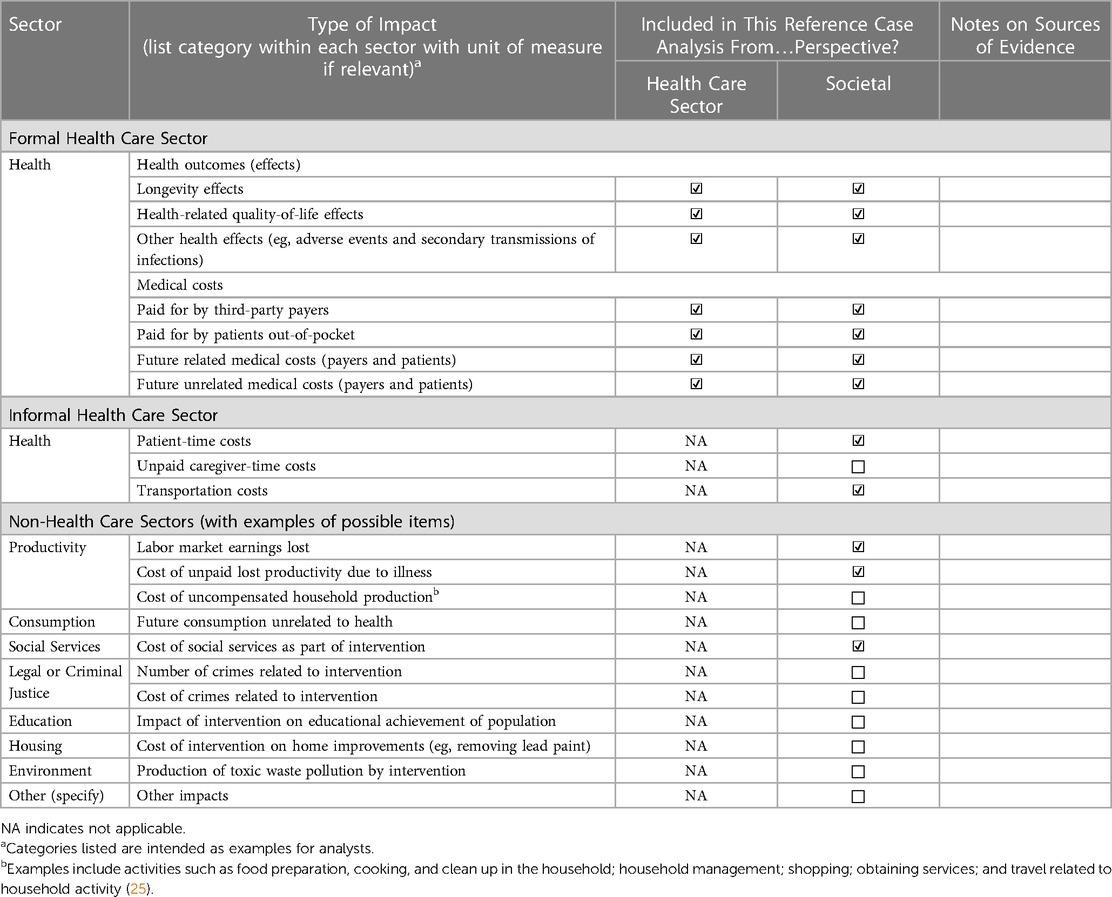
Table 5. Impact inventory, adapted from sanders et al., 2016 (24).
Direct medical costs will include those associated with laboratory tests, health facility visits for STIs, and medications for STI treatment. These costs will be calculated by multiplying the amounts of resources used by their unit costs. We will track direct medical resource uses through our micro-costing approach. The unit costs associated with physician visits for specific diagnoses, laboratory tests and drugs will be derived from various fee schedules (30). Direct non-medical costs (e.g., patient transportation costs), indirect costs (e.g., lost productivity), and intangible costs (e.g., psychosocial costs or pain and suffering) will be excluded from this study, given the perspective adopted. We will combine the implementation costs and direct medical costs to calculate the total costs associated with each experimental arm.
All costs and benefits will be discounted at the conventional 3% annual discount rate. As the value of health effects of prevention tends to increase over time (e.g., each HIV infection detected or each new woman treated with PrEP may avert new HIV infections) (31), we will also conduct robustness analyses with higher discount rates for the health benefits. In addition, we will adjust for inflation by indexing all prices to a single year's prices (e.g., year 2023 prices), using consumer price indices from the US Bureau of Labor Statistics.
Using the estimated effectiveness and costs above, we will calculate the relative efficiency of each active intervention (i.e., patient-focused intervention and patient-focused intervention plus EHR alerts) relative to standard of care in terms of their incremental cost-effectiveness ratios (ICER), calculated as the ratio of each intervention's incremental costs to its incremental benefits (e.g., incremental new STI/HIV test, new STI/HIV case diagnosed, number of new women on PrEP), and expressed in terms of dollars per health benefits. The ICER will be compared to a payer's “opportunity cost,” i.e., willingness-to-pay (WTP) threshold, to determine the intervention's acceptability in terms of its efficiency in generating health benefits and under the implementation strategy. An ICER below the WTP threshold will be indicative of good value for money produced by the intervention. We will also calculate the net and incremental monetary and health benefits of alternative interventions.
To characterize uncertainty's impact on the recommended alternatives' robustness, we will first conduct deterministic and probabilistic sensitivity analyses (DSA and PSA). These analyses will help identify the most influential measures (DSA) and assess the joint effects of uncertainties in all cost and effectiveness measures on the distributions of the ICER (PSA). Values generated by the multivariate PSA will enable us to construct credible simulation intervals around key outcome measures, and to estimate the cost-effectiveness acceptability curves (CEAC) and frontier (CEAF) (32–36), the expected loss curves (ELCs), and the cost-effectiveness risk-aversion curves (CERAC) (37).
Second, a budget impact analysis will be conducted to estimate the affordability of adopting alternative interventions. Cost-effectiveness affordability curves (CEAFC) will be constructed to characterize both dimensions of the joint distribution of incremental costs and effects on the cost-effectiveness plane (38).
Third, we will conduct a return-on-investment (ROI) analysis to quantify the profitability of alternative interventions.
Last, we will apply the innovative method of distributional cost-effectiveness analysis (DCEA) to quantify the health equity impact of alternative interventions and implementation strategies, and to assess potential tradeoffs between their costs, health benefits, and equity impacts across women in different race/ethnic groups (e.g., White, Black, Hispanic women) (39).
We will measure health equity impact in terms of the equally distributed equivalent (EDE) value of the incremental net health benefit (INHB), which adjusts the INHB to account for equity considerations, using a social welfare evaluation function (SWF) such as the Gini, the Atkinson-Sen, and Kolm-Polack SWF (40, 41). The EDE value represents the level of the effectiveness outcome that, if provided uniformly to every group in a population, would yield the same amount of social welfare to the distribution of that outcome (40).
Results will be presented in the equity impact plane, which captures potential trade-offs between the net equity impact and the net health impacts of alternative interventions. Efficiency-equity tradeoff curves will also be constructed to convey the worthiness of each intervention to the payer or decision-maker at different levels of aversion to inequality and WTP threshold.
Discussion
Our study will focus on three of the four pillars of the EHE in the U.S.—diagnosing HIV with immediate linkage to treatment services, and preventing new HIV infection with PrEP initiation—targeting OB/GYN providers and their patients (42). Our hybrid type II effectiveness-implementation trial seeks to prevent new HIV transmissions by increasing patient awareness of HIV risk factors and educating at-risk patients about prevention strategies, inclusive of PrEP. Furthermore, increasing HIV testing among our patients should make a lasting impact on the clinical care of U.S. cisgender women.
The strengths of our study include the exclusive focus on U.S. cisgender women, who currently are not the target of most HIV prevention studies in the U.S. Second, we created interventions and an implementation strategy that addressed commonly cited patient- and provider-level barriers to PrEP initiation and HIV testing. Some of the interventions and strategies include utilizing EHR automation to decrease provider burden and digitizing a sexual history questionnaire to remove discomfort with asking or answering questions related to sexual history and behaviors. Third, we targeted OB/GYN providers who routinely discuss sexual behaviors and STIs and appear to be ideal prescribers of PrEP for women. Fourth, we apply a battery of economic evaluation analyses to quantify the value for money of the alternative interventions, to better inform decision-making and guide sustainability efforts. However, there are limitations. First, our HIV efforts will only impact women who are engaged in clinical care. However, we included two Federally Qualified Health Centers, which are safety net clinics that provide care to patients regardless of insurance coverage. Next,our study will only be generalizable to clinics with EHRs, which are costly systems. Lastly, the primary outcome measure of the number of PrEP prescriptions ordered will not necessarily equate to the medications received and taken by the targeted patient. However, when possible, we will determine whether the prescription had been filled and medication taken.
In sum, our novel multimodal, multilevel implementation science protocol seeks to test the feasibility, acceptability, and efficacy of a scored digital sexual health questionnaire intervention and EHR implementation strategy to increase HIV prevention strategies and PrEP initiation among U.S. cisgender women during routine OB/GYN clinics.
Ethics statement
The studies involving human participants were reviewed and approved by The Johns Hopkins Medicine Office of Human Subjects Research Institutional Review Boards. Written informed consent from the participants' legal guardian/next of kin was not required to participate in this study in accordance with the national legislation and the institutional requirements.
Author contributions
LI was a major contributor to the writing and formatting of all sections of the manuscript. OM was a major contributor to all sections of the manuscript, as well as the writing and formatting of the original study protocol and grant application. ED was a major contributor to the methodology and economic evaluation section of the manuscript, as well as the writing and formatting of the original study protocol and grant application. JP was a major contributor to the methodology, randomization of recruited participants, and quantitative analysis sections of the manuscript, as well as the writing and formatting of the original study and grant application. SM was a major contributor to the writing and formatting of the original study protocol and grant application. JC was a major contributor to all sections of the manuscript, as well as the writing and formatting of the original study protocol and grant application. All authors were involved in the revisions and final approval of the manuscript. All authors contributed to the article and approved the submitted version.
Funding
All investigators are supported by the National Institute of Mental Health; US National Institutes of Health (1R01MH132146).
Acknowledgments
The authors would like to thank the providers, nurses, clinic managers, medical assistants, and front desk staff at each of the targeted OB/GYN clinics for their efforts and contributions.
Conflict of interest
The authors declare that the research was conducted in the absence of any commercial or financial relationships that could be construed as a potential conflict of interest.
Publisher's note
All claims expressed in this article are solely those of the authors and do not necessarily represent those of their affiliated organizations, or those of the publisher, the editors and the reviewers. Any product that may be evaluated in this article, or claim that may be made by its manufacturer, is not guaranteed or endorsed by the publisher.
Supplementary material
The Supplementary Material for this article can be found online at https://www.frontiersin.org/articles/10.3389/frph.2023.1196392/full#supplementary-material.
SUPPLEMENTARY ADDITIONAL FILE S1
entails the SPIRIT compliant checklist for this randomized trial.
SUPPLEMENTARY ADDITIONAL FILE S2
entails the CONSORT compliant checklist extension for this cluster-randomized trial.
SUPPLEMENTARY ADDITIONAL FILE S3
entails the TIDIeR compliant checklist for the interventions in this study.
SUPPLEMENTARY ADDITIONAL FILE S4
entails the approval letter received by our ethics committee to conduct this trial.
SUPPLEMENTARY ADDITIONAL FILE S5
entails the original study protocol reviewed and approved by our ethics committee.
References
1. Prevention CfDC. Monitoring selected national HIV prevention and care objectives by using surveillance data — united States and 6 dependent areas, 2019. Cent Dis Cont Prev. (2021) 26:43–45. Contract No.: 2.
2. Carley T, Siewert E, Naresh A. Interest in Pre-exposure prophylaxis (PrEP) for HIV is limited among women in general obstetrics and gynecology setting. AIDS Behav. (2019) 23:2741–8. doi: 10.1007/s10461-019-02529-1
4. Huang YA, Zhu W, Smith DK, Harris N, Hoover KW. HIV Preexposure prophylaxis, by race and ethnicity—united States, 2014-2016. Morb Mortal Wkly Rep (MMWR). (2018) 67(41):1147–50. doi: 10.15585/mmwr.mm6741a3
5. Karletsos D, Stoecker C. Impact of medicaid expansion on PrEP utilization in the US: 2012-2018. AIDS Behav. (2021) 25:1103–11. doi: 10.1007/s10461-020-03070-2
6. Frew PM, Parker K, Vo L, Haley D, O’Leary A, Diallo DD, et al. Socioecological factors influencing women’s HIV risk in the United States: qualitative findings from the women’s HIV SeroIncidence study (HPTN 064). BMC Public Health. (2016) 16(803):1–18. doi: 10.1186/s12889-016-3364-7
7. Hong JN, Farel CE, Rahangdale L. Pharmacologic prevention of human immunodeficiency virus in women: practical approaches for the obstetrician and gynecologist. Obstet Gynecol Surv. (2015) 70(4):284–90. doi: 10.1097/OGX.0000000000000170
8. Krakower D, Mayer KH. Engaging healthcare providers to implement HIV pre-exposure prophylaxis. Curr Opin HIV AIDS. (2012) 7(6):593–9. doi: 10.1097/COH.0b013e3283590446
9. Seidman D, Carlson K, Weber S, Witt J, Kelly PJ. United States Family planning providers’ knowledge of and attitudes towards preexposure prophylaxis for HIV prevention: a national survey. Contraception. (2016) 93(5):463–9. doi: 10.1016/j.contraception.2015.12.018
10. Maryland. Maryland Code HEALTH—GENERAL Title 18—DISEASE PREVENTION Subtitle 3—SPECIFIC DISEASES Part VI—ACQUIRED IMMUNE DEFICIENCY SYNDROME (AIDS) § 18-336—Testing (Available at: https://law.justia.com/codes/maryland/2015/article-ghg/title-18/subtitle-3/part-vi/section-18-336/) (2015).
11. Liao C, Golden WC, Anderson JR, Coleman JS. Missed opportunities for repeat HIV testing in pregnancy: implications for elimination of mother-to-child transmission in the United States. AIDS Patient Care STDS. (2017) 31(1):20–6. doi: 10.1089/apc.2016.0204
12. Prevention CfDCa. US Public Health Service: Preexposure prophylaxis for the prevention of HIV infection in the United States—2021 Update: a clinical practice guideline (2021).
13. Local Data: Baltimore-Columbia-Towson MSA. Available at: https://aidsvu.org/local-data/united-states/south/maryland/baltimore/#:∼:text=In%202019%2C%20there%20were%2018%2C276,were%20newly%20diagnosed%20with%20HIV (2019).
14. Force USPST, Owens DK, Davidson KW, Krist AH, Barry MJ, Cabana M, et al. Screening for HIV infection: uS preventive services task force recommendation statement. JAMA. (2019) 321(23):2326–36. doi: 10.1001/jama.2019.6587
15. Ronda J, Gaydos CA, Perin J, Tabacco L, Coleman JS, Trent M. Does the sex risk quiz predict mycoplasma genitalium infection in urban adolescents and young adult women? Sex Transm Dis. (2018) 45(11):728–34. doi: 10.1097/OLQ.0000000000000874
16. Force USPST, Owens DK, Davidson KW, Krist AH, Barry MJ, Cabana M, et al. Preexposure prophylaxis for the prevention of HIV infection: uS preventive services task force recommendation statement. JAMA. (2019) 321(22):2203–13. doi: 10.1001/jama.2019.6390
17. Sismanidis C, Moulton LH, Ayles H, Fielding K, Schaap A, Beyers N, et al. Restricted randomization of ZAMSTAR: a 2 (2 factorial cluster randomized trial. Clin Trials. (2008) 5(4):316–27. doi: 10.1177/1740774508094747
18. Moulton LH. Covariate-based constrained randomization of group-randomized trials. Clini Trials. (2004) 1(3):297–305. doi: 10.1191/1740774504cn024oa
21. Fruhauf T, Coleman JS. A missed opportunity for U.S. Perinatal human immunodeficiency virus elimination: pre-exposure prophylaxis during pregnancy. Obstet Gynecol. (2017) 130(4):703–9. doi: 10.1097/AOG.0000000000002258
22. Achana F, Gallacher D, Oppong R, Kim S, Petrou S, Mason J, et al. Multivariate generalized linear mixed-effects models for the analysis of clinical trial–based cost-effectiveness data. Med Decis Making. (2021) 41(6):667–84. doi: 10.1177/0272989X211003880
23. Busetto L, Wick W, Gumbinger C. How to use and assess qualitative research methods. Neurol Res Pract. (2020) 2:14. doi: 10.1186/s42466-020-00059-z
24. Sanders GD, Neumann PJ, Basu A, Brock DW, Feeny D, Krahn M, et al. Recommendations for conduct, methodological practices, and reporting of cost-effectiveness analyses second panel on cost-effectiveness in health and medicine. JAMA. (2016) 316(10):1093–103. doi: 10.1001/jama.2016.12195
25. Grosse SD, Krueger KV, Mvundura M. Economic productivity by age and sex: 2007 estimates for the United States. Med Care. (2009) 47(7):S94–103. doi: 10.1097/MLR.0b013e31819c9571
26. Barr DJ, Levy R, Scheepers C. Random effects structure for confirmatory hypothesis testing: keep it maximal. Tily, Harry J. (2013) 68:1093–103. doi: 10.1001/jama.2016.12195
27. Drummond MF, Sculpher MJ, Claxton K, Stoddart GL, Torrance G. Methods for the Economic Evaluation of Health Care Programmes (2015).
28. Neumann PJ, Sanders GD, Russell LB, Siegel JE. Ganiats TG. Cost-effectiveness in health and medicine. 2 ed. New York, NY: Oxford University Press (2016).
29. Holtgrave DR. Costs and consequences of the US centers for disease control and prevention’s recommendations for opt-out HIV testing. PLoS Med. (2007) 4:194. doi: 10.1371/journal.pmed.0040194
30. Glick HA, Doshi JA, Sonnad SS, Polsky D. Economic evaluation in clinical trials. 2 ed. New York, NY: Oxford University Press (2014).
31. Gravelle H, Smith D. Discounting for health effects in cost-benefit and cost-effectiveness analysis. Health Econ. (2001) 10:587–99. doi: 10.1002/hec.618
32. Van Hout BA, Al MJ, Gordon GS, Rutten FF. Costs, effects and C/E-ratios alongside a clinical trial. J Health Econ. (1994) 3(5):309–19. doi: 10.1002/hec.4730030505
33. Fenwick E, Claxton E, Sculpher M. Representing uncertainty: the role of cost-effectiveness acceptability curves. J Health Econ. (2001) 10(8):779–87. doi: 10.1002/hec.635
34. Fenwick E, O'Brien BJ, Briggs A. Cost-effectiveness acceptability curves–facts, fallacies and frequently asked questions. Health Econ. (2004) 13(5):405–15. doi: 10.1002/hec.903
35. Fenwick E, Byford S. A guide to cost-effectiveness acceptability curves. Br J Psychiatry. (2005) 187:106–8. doi: 10.1192/bjp.187.2.106
36. Alarid-Escudero F, Enns EA, Kuntz KM, Michaud TL, Jalal H. “Time traveling is just too dangerous” but some methods are worth revisiting: the advantages of expected loss curves over cost-effectiveness acceptability curves and frontier. Value Health. (2019) 22(5):611–18. doi: 10.1016/j.jval.2019.02.008
37. Sendi P. Dealing with bad risk in cost-effectiveness analysis: the cost-effectiveness risk-aversion curve. Pharmoeconomics. (2021) 39(2):161–9. doi: 10.1007/s40273-020-00969-5
38. Sendi P, Matter-Walstra K, Schwenkglenks M. Handling uncertainty in cost-effectiveness analysis: budget impact and risk aversion. Healthcare (Basel, Switzerland). (2021) 9(11):1419. doi: 10.3390/healthcare9111419
39. Asaria M, Griffin S, Cookson R. Distributional cost-effectiveness analysis: a tutorial. Med Decis Making. (2016) 36(1):8–19. doi: 10.1177/0272989X15583266
40. Atkinson AB. On the measurement of inequality. J Econ Theory. (1970) 2(3):244–63. doi: 10.1016/0022-0531(70)90039-6
Keywords: pre-exposure prophylaxis (PrEP), HIV prevention, ending the HIV epidemic (EHE), cisgender women, EHR intervention, digital health
Citation: Izadi LH, Mmeje O, Drabo EF, Perin J, Martin S and Coleman JS (2023) An effectiveness-implementation trial protocol to evaluate PrEP initiation among U.S. cisgender women using eHealth tools vs. standard care. Front. Reprod. Health 5:1196392. doi: 10.3389/frph.2023.1196392
Received: 29 March 2023; Accepted: 15 May 2023;
Published: 8 June 2023.
Edited by:
Garumma Tolu Feyissa, Drexel University, United StatesReviewed by:
Arshad Altaf, WHO Regional Office for the Eastern Mediterranean, EgyptKathryn Therese Mngadi, Aurum Institute, South Africa
© 2023 Izadi, Mmeje, Drabo, Perin, Martin and Coleman. This is an open-access article distributed under the terms of the Creative Commons Attribution License (CC BY). The use, distribution or reproduction in other forums is permitted, provided the original author(s) and the copyright owner(s) are credited and that the original publication in this journal is cited, in accordance with accepted academic practice. No use, distribution or reproduction is permitted which does not comply with these terms.
*Correspondence: Lillee H. Izadi bGl6YWRpMUBqaC5lZHU=
 Lillee H. Izadi
Lillee H. Izadi Okeoma Mmeje
Okeoma Mmeje Emmanuel F. Drabo
Emmanuel F. Drabo Jamie Perin
Jamie Perin Stephen Martin5
Stephen Martin5 Jenell S. Coleman
Jenell S. Coleman